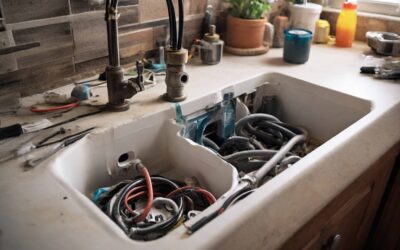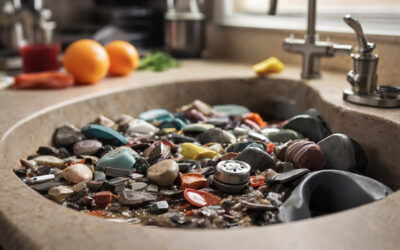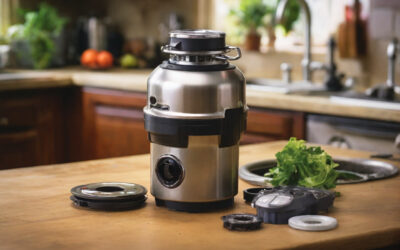Plumbing has come a long way in terms of longevity and efficiency. With the modern advancement of other plumbing instruments did not lag. From the clay type pipe to the new modern and more sturdy type pipes. Plumbing is truly rising to a new height for better liveability. With all the vast choices in the market, the thing now raises a question of what are the best pipes for plumbing. On this basis, people with new projects in hand have this question of What Type of Plumbing is Used in New Homes.
Copper and PEX are commonly used for plumbing in new homes due to their durability and versatility. When building a new home, it is crucial to choose the right type of plumbing. Because it will be able to withstand the pressure and offer your long-term service as well as efficient water supply.
Copper and PEX (cross-linked polyethylene) pipes are two popular choices for plumbing systems in new homes. Copper pipes are known for their durability and long lifespan, making them a reliable option for homeowners. They are resistant to corrosion, withstand high temperatures, and are widely available.
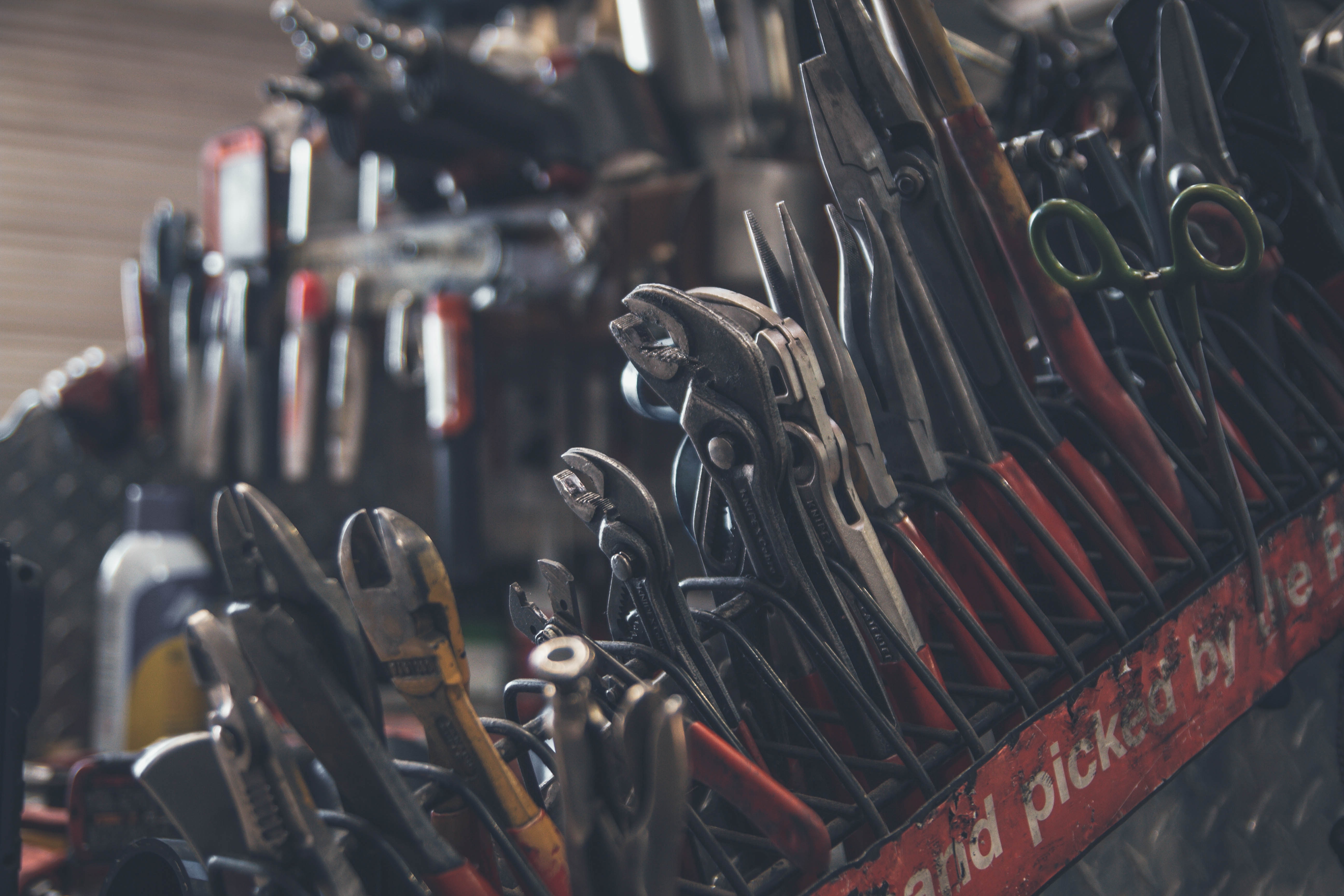
On the other hand, PEX pipes offer flexibility and are easier to install, making them a cost-effective choice. They are also resistant to freezing and bursting, ensuring a reliable water supply in colder climates. Overall, both copper and PEX pipes provide reliable and durable plumbing solutions for new homes.
So figuring out the value and flexibility of installation is what makes the real confusion. In terms of sturdy build, one may offer longer safety but problems with installation and changing. While the other may be more flexible in terms of plumbing work hence giving less longevity to piping appliances.
Traditional Plumbing Systems
New homes typically feature traditional plumbing systems, incorporating a network of pipes and fixtures. These systems’ design helps to efficiently supply water and remove waste, ensuring a reliable and durable plumbing infrastructure for homeowners. With the use of quality materials and professional installation, traditional plumbing systems deliver long-lasting functionality for new properties.
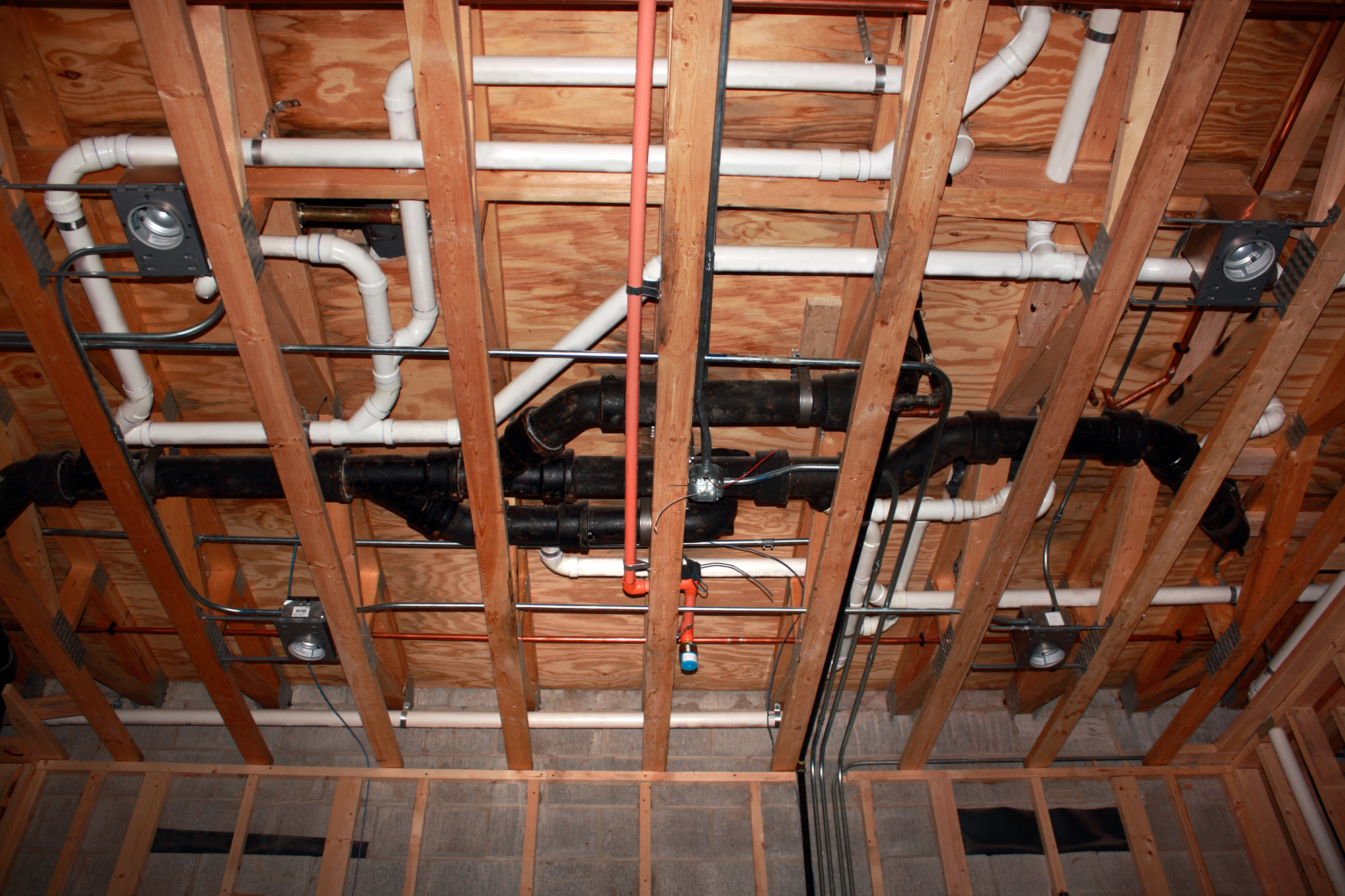
When it comes to plumbing in new homes, there are several types of pipes to use for efficient water flow. Traditional plumbing systems commonly include copper, PVC, and galvanized steel pipes. Each type of pipe has its characteristics and benefits. Making it essential to understand the differences and choose the most suitable option for your home’s plumbing needs.
Copper Plumbing
Copper plumbing pipes have been a favorite choice in residential plumbing for many years. This type of pipe is known for its durability, corrosion resistance, and high heat tolerance. Which is ideal for both hot and cold water applications. Copper pipes are widely known for their long lifespan, often lasting up to 50 years. Additionally, these pipes have excellent water pressure capabilities, ensuring optimal water flow throughout the home.
When it comes to copper piping fittings, plumbers use soldering to connect the pipes. This creates a secure and leak-free joint. Furthermore, copper pipes are an environmentally friendly option as you can recycle and reuse them when you like.
PVC Plumbing
PVC (Polyvinyl Chloride) plumbing pipes are another popular choice for new home installations. This type of pipe is lightweight, affordable, and easy to work with. PVC pipes are resistant to chemicals, corrosion, and abrasion, making them suitable for various plumbing applications.
One of the significant advantages of PVC pipes is their smooth inner surface. Helping to prevent the build-up of mineral deposits and improving water flow. Additionally, PVC pipes do not pose health risks as they are non-toxic and do not leach harmful substances into the water.
Galvanized Steel Plumbing
Galvanized steel pipes were commonly used in older homes but are less prevalent in new construction. The pipes have a steel coating with a layer of zinc, protecting against corrosion. Galvanized steel pipes have strength and durability, making them suitable for high-water pressure systems.
However, there are some drawbacks to using galvanized steel pipes. Over time, the zinc coating may wear off, leading to rust and potentially reducing water quality. Additionally, galvanized steel pipes are prone to scaling and may develop clogs over time, affecting water flow.
It is crucial to keep in mind that traditional plumbing systems offer reliable options. Newer materials such as PEX (cross-linked polyethylene) pipes are gaining popularity because of flexibility and ease of installation.
Modern Plumbing Systems
PEX Plumbing
In new homes, modern plumbing systems work to ensure efficient water flow and durability. One of the popular choices for water piping in new homes is PEX (cross-linked polyethylene) plumbing. PEX pipes are flexible and easy to install, making them a cost-effective option for residential plumbing. Since this pipe can get any shape easily bending and compressing is much easier. Which is why they are useful for various plumbing applications in new construction projects.
CPVC Plumbing
Another type of plumbing material useful for modern homes is CPVC (Chlorinated Polyvinyl Chloride). CPVC pipes are known for their resistance against corrosion and high temperatures. Which is why they are suitable for hot and cold water distribution systems. These pipes are lightweight, easy to install, and have a relatively low cost. This makes the CPVC a popular choice for residential plumbing installations.
ABS Plumbing
ABS (Acrylonitrile Butadiene Styrene) pipes for plumbing are very common for drainage and waste systems in new homes. ABS pipes are lightweight, durable, and resistant to chemicals, making them a suitable choice for plumbing applications. Usual for vent and drain lines in residential plumbing systems, providing reliable and long-lasting performance.
Comparing What Type Of Plumbing Is Used In New Homes
New homes feature a variety of plumbing options, including copper, PEX, and PVC pipes. Each material has its benefits and drawbacks, making it important to weigh the pros and cons before making a decision.
For new homes, the types of pipe in plumbing greatly impact the overall functionality and longevity of the system. In this section, we will compare types of pipes for plumbing systems. Which will help you identify and types of pipes helpful to you. For this, we will go through all the pros and cons of each option. From durability and lifespan to installation costs and environmental impact. We will delve into the factors that can influence your decision on what type of pipes are suitable for a new home.
Durability And Lifespan
Durability and lifespan are crucial considerations when it comes to choosing the right plumbing system for your new home. Here are some comparisons between different plumbing pipe types:
- Copper pipes: With their excellent corrosion resistance and proven longevity, copper pipes are a popular choice for many homeowners. They can withstand high pressures and are known for their durability which can last for several decades.
- PEX pipes: Cross-linking polyethylene (PEX) pipes are gaining popularity due to their flexibility and resistance to corrosion. With a lifespan of around 50 years, they offer a durable and long-lasting solution for new homes.
- CPVC pipes: Chlorinated polyvinyl chloride (CPVC) pipes are known for their resistance to scaling, corrosion, and high temperatures. With a lifespan of around 50 years, CPVC pipes provide a reliable option for new home plumbing systems.
- Galvanized steel pipes: Although galvanized steel pipes were common in the past. At present time their popularity and demand are declining. Due to their susceptibility to rust and corrosion over time. Their lifespan is typically around 40-50 years.
Installation Costs
The cost of installing a plumbing system is an important factor to consider when building a new home. Here’s a comparison of the installation costs associated with different types of plumbing:
| Plumbing Pipe Type | Installation Costs |
| Copper pipes | $8 – $15 |
| PEX pipes | $0.75 – $2 |
| CPVC pipes | $1.5 – $3 |
| Galvanized steel pipes | $10 – $18 |
Please note that these costs may vary depending on factors. Things like location, size of the home, local labor rates, and the complexity of the installation. All of this can raise the cost of installation for an overall setup.
Maintenance Requirements
Maintaining your plumbing system is essential for its long-term performance. Here’s a comparison of the maintenance requirements for different plumbing pipe types:
Copper pipes
Copper pipes require minimal maintenance and are less prone to leaks and blockages.
PEX pipes
PEX pipes have fewer joints and fittings, reducing the chances of leakage. They also have excellent resistance to scaling and corrosion.
CPVC pipes
CPVC pipes are low-maintenance and do not require frequent upkeep. They are resistant to scaling, corrosion, and microbial growth.
Galvanized steel pipes
Galvanized steel pipes tend to require more maintenance due to their susceptibility to rust and corrosion. Regular inspections are necessary to prevent leaks and ensure optimal performance.
Water Flow And Pressure
The water flow and pressure in your home are crucial for day-to-day activities. Different plumbing pipe types can have varying effects on water flow and pressure:
- Copper pipes: Copper pipes provide excellent water flow and maintain consistent pressure throughout the system. They are ideal for homes that require high water pressure.
- PEX pipes: PEX pipes offer excellent water flow and have the advantage of being highly flexible, allowing for easy installation in tight spaces.
- CPVC pipes: CPVC pipes maintain good water flow and pressure, making them suitable for most residential plumbing needs.
- Galvanized steel pipes: Over time, galvanized steel pipes can develop restrictions and reduce water flow due to rust and corrosion buildup.
Environmental Impact
Considering the environmental impact of your plumbing system is essential for sustainable living. Here’s a comparison of the environmental impact these types of pipe tend to do in plumbing:
Copper pipes
Copper is a recyclable material, making copper pipes environmentally friendly. However, the mining and production processes might have certain environmental impacts.
PEX pipes
PEX pipes are generally environmentally friendly due to their energy-efficient production process. They also have a lower carbon footprint in comparison to other materials.
CPVC pipes
CPVC pipes are recyclable and require less energy during the manufacturing process. Which is why they are more environmentally friendly compared to some alternatives.
Galvanized steel pipes
Galvanized steel pipes have a higher environmental impact due to the energy-intensive manufacturing process and the potential for rust and corrosion to contaminate water sources.
Ultimately, having everything in consideration the impact it leaves on leaves room for discussion. So, in order to find out what type of plumbing system that best fits your new home. You need to have everything single detail under your command for better results.
4. Factors To Consider When Choosing What Type Of Plumbing Is Used In New Homes
Factors to consider when choosing the type of plumbing in new homes include budget, water efficiency, durability, and maintenance requirements. It is important to assess these factors to ensure optimal performance and long-term satisfaction with the plumbing system.
When it comes to choosing the right plumbing system there are several important factors that you need to consider. Each factor plays a crucial role in determining what type of plumbing is best suited for your specific requirements. By carefully considering these factors, you can ensure that your new home’s plumbing system not only meets your expectations. But also provides an efficient and reliable water supply throughout your house.
Budget
In any building project, budget is a critical factor that influences the decision-making process. The same applies to choosing a plumbing system for your new home. Your budget will determine the type of plumbing pipes, fittings, and fixtures that you can afford. It is important to strike a balance between cost and quality when selecting plumbing materials. While it may be tempting to opt for cheaper options. It is crucial to consider the long-term maintenance and durability of the plumbing system. Choosing high-quality plumbing pipes may require a higher initial investment. But it is worth the investment. As it can save you from costly repairs and replacements in the future.
Water Quality
The quality of water in your area is another crucial factor. It helps immensely when choosing the type of plumbing system for your new home. Different areas have different levels of water hardness. Which can have a significant impact on the lifespan and performance of your plumbing pipes. Hard water contains minerals that can cause corrosion and buildup within the pipes. Which leads to reduced water flow and potential blockages. By considering the water quality in your area, you can select pipes that are resistant to corrosion. Fairly helping you to minimize the risk of scaling and clogging.
Climate
The climate of your location plays a significant role in determining the type of plumbing pipes that are best for your new home. Extreme temperatures, such as freezing winters or scorching summers, can have adverse effects on certain types of pipes. In regions with freezing temperatures, it is important to choose pipes that are resistant to freezing and bursting. In areas with high heat or direct sunlight. Selecting pipes with UV resistance can prevent degradation and prolong the lifespan of your plumbing system.
Future Renovations
Consider any potential future renovations or expansions that you may have in mind for your new home. If you anticipate making changes to the layout or adding additional fixtures in the future. It is essential to choose a plumbing system that offers flexibility and easy modifications. Some plumbing systems allow for more straightforward alterations, while others may require more extensive and costly modifications. By considering future renovations, you can ensure that your plumbing system is adaptable and can accommodate any changes or upgrades in the future.
Frequently Asked Questions
What Type Of Plumbing Pipes Are Commonly Used In New Homes?
Commonly used plumbing pipes in new homes include copper, PVC, and PEX. Each has its benefits and suitability.
How Long Does Plumbing Last In A New Home?
The lifespan of plumbing in a new home varies. Typically it ranges from 25 to 40 years, depending on the materials used and maintenance.
What Are The Advantages Of Using Pex Plumbing In New Homes?
PEX plumbing offers advantages such as flexibility, resistance to freezing, and easier installation, making it a popular choice for new homes.
Conclusion
New homes typically use a combination of PVC, copper, and PEX plumbing pipes. Each material has its advantages. So it’s important to consider factors like cost, durability, and building codes when choosing. Then the right knowledge about What Type of Plumbing is Used in New Homes really leaves its fair share of importance. By knowing about the options, homeowners can make informed decisions for their plumbing needs.




